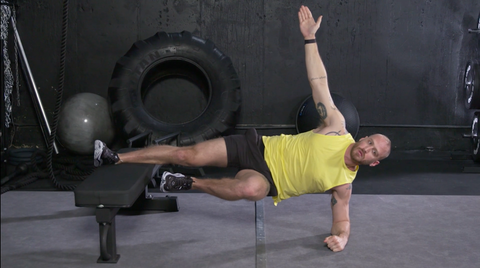How often have you dismissed the plank? Sure, it’s a simple movement that doesn’t stir much excitement when you see someone holding the position in a corner of the gym—but if you level up to one of the toughest variations of the exercise around, the Copenhagen plank, you won’t be so quick to snub your nose.
Underrated and underused (and maybe initially overwhelming on first attempt), the Copenhagen plank without question is one of the most challenging plank variations out there. One major advantage of the Copenhagen plank is that there’s little chance that you’ll get bored. Forget counting your reps in minutes. If you do it right, you should be giving everything you have for seconds.
But once you master it, according to Men’s Health fitness director Ebenezer Samuel, C.S.C.S., and fitness editor Brett Williams, N.A.S.M., the Copenhagen plank will provide plenty of core-crushing benefits, especially if you’re a runner.
How to Do the Copenhagen Plank
Normally when we think side plank, we prioritize bracing our entire core. The Copenhagen is a little bit different, according to Samuel.
“Because we’re going to work a lot of lateral stability in this plank, you’re going to start to get a lot of hip effect,” Samuel says. “Your adductors and abductors and both your inner and outer thighs are going to wind the firing in this move as well.”
You’ll also notice that you’re actually set up in a position that mirrors a runner’s stride, so be aware of reinforcing a good, high-knee position, and make sure you can own it in the sagittal plane.
Get Set Up on the Bench
To start, you’ll need a bench, or ideally a raised platform that doesn’t have a back on it, like an ottoman. This will allow you to scale your plank’s difficulty level. And trust us, you’ll first need to make adjustments.
Place your top shin on the bench. You’ll notice the closer you get your knee to the bench, the easier it becomes as you’re working with less lever. Move it out more, and the lever becomes longer and more challenging. We suggest starting about two inches out.
Hold a Strong Side Plank
From here, think of a side plank.In other words, place your forearm perpendicular to your torso on the ground—that’s going to protect your shoulder, then shift into a safer external rotation. Think about squeezing both shoulder blades and glutes.
You’re almost there, but Samuel says there’s one final piece to the Copenhagen puzzle. As this move is already creating a ton of tension through your glutes and shoulder blades, keeping your free leg raised and in the proper 90 degree position is serious anti-rotation work for your core. For runners, this position reinforces the posture you want when you run.
Again, you’ll hold a Copenhagen plank nowhere near the same amount of time you would a standard plank. And since it is so challenging, it’s best to make this your first move of your core workout.
Remember the Copenhagen keys: maintain stability and squeeze your glutes and shoulder blades while fighting off rotation in both directions. If you can nail those, you’ve just dominated the once-indomitable exercise.
“That’s what makes this a great plank,” Samuel says. “This is a super challenging move, but that’s the idea.”
Want to master even more moves? Check out our entire Form Check series.
This content is created and maintained by a third party, and imported onto this page to help users provide their email addresses. You may be able to find more information about this and similar content at piano.io



Comments are closed.